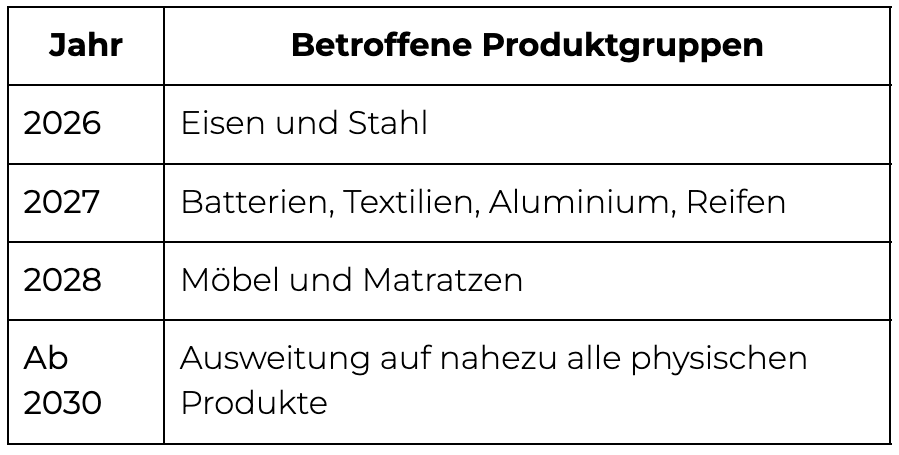From 2027, the Digital Product Passport (DPP) will be mandatory for the first product categories in the EU. It is a central element of the Ecodesign for Sustainable Products Regulation (ESPR), which is part of the EU Green Deal, and is intended to create the basis for a sustainable and circular economy.
The DPP bundles digital information on a product over its entire life cycle, from manufacture to disposal. This includes information on material composition, carbon footprint, reparability, and recyclability. This data is made accessible via a Unique Product Identifier (UPI) such as a QR code or RFID chip (Fraunhofer).
For companies, this means, “No passport, no market access.”
In the future, products without a DPP may no longer be sold in the EU internal market (VCI).
Why action is crucial now
The timetable is ambitious: companies only have around two years to prepare for the new requirements. The battery passport, which will become mandatory for all electric vehicle and industrial batteries with more than 2 kWh from February 18, 2027, is the first major practical test and gives a foretaste of the upcoming requirements (Fraunhofer).
It will be introduced in stages and will affect other sectors over the coming years:

Particularly important: Suppliers are also obliged to provide relevant data. Without this data, it is not possible to create a complete DPP for the end product. Companies in the supply chain must therefore check at an early stage what information they can provide and which processes need to be adapted for this (Fluxy.One).
Webcast everything you need to know about the EU Digital Product Passport (DPP).
Challenges for companies
The introduction of the DPP is not just an IT project. It requires a holistic approach that encompasses data, processes, and organization.
1. Data integration and quality
The relevant information is often stored in isolated systems such as ERP, PIM, or PLM. In addition, there are external certificates or manual processes. The biggest hurdle is the consolidation and standardization of these data silos. Standards such as the Asset Administration Shell (AAS) and ECLASS are crucial for the interoperable exchange of data.
2. Collaboration in the supply chain
The DPP makes the entire value chain transparent. Companies are dependent on their suppliers also providing data in the required quality and in the correct format.
3. Organizational anchoring
The DPP not only affects IT departments, but also product management, purchasing, production, and compliance. The topic must therefore be anchored at the management level.
4. Regulatory uncertainty
As not all details of the EU regulation have been finalized, companies tend to wait and see. However, this hesitation can be dangerous. If you start too late, you risk time pressure and high costs in the implementation phase.
Opportunities through the DPP
Many initially see the DPP as a bureaucratic obligation. However, with a strategic approach, it opens up new opportunities:
Transparency and trust: Customers, partners, and investors receive reliable information on the origin, sustainability, and environmental impact of products (VDI).
- New business models: Data enables innovative approaches such as product-as-a-service, optimized take-back systems, or trade-in secondary raw materials.
- Optimized processes: The harmonization of product data improves internal processes and reduces costs in the long term.
- Competitive advantage: Companies that start early can position themselves as pioneers in sustainability and digitalization.
How to get started - step by step
A pragmatic approach makes it easier to get started and reduces risks:
- Kick-off workshop: Define responsibilities, scope, and stakeholders.
- Data inventory: take stock of existing product data and identify gaps.
- Pilot project: Start with a single product or line to gain experience.
- Implement standards and tools: Choose open, interoperable solutions, e.g. AAS and GS1 Digital Link.
- Scaling: Roll out to other product groups and markets.
An example from the mechanical engineering sector shows how a proof of concept with AAS and ECLASS not only led to DPP compliance, but also to new business models such as predictive maintenance (VDMA).
Conclusion
The Digital Product Passport will fundamentally change the way companies develop, manufacture, and distribute products.
Those who act early can use the DPP not only to meet regulatory requirements, but also as a lever for digitalization, efficiency, and new business models.
➡ Inform and prepare now: Visit our landing page regarding the Digital Product Passport and find out how we can support you on the path to implementation: www.techdivision.com/en/digita-product-passport
We would also like to invite you to our SPIN Digital Experience Lab so that you can not only experience DPP approaches live in a coherent demo environment, but also try them out for yourself.
Do you have any questions?
Simply fill in the form opposite or send us an e-mail to anfragen (at) techdivision.com or call us on +49 8031 22105-0.


